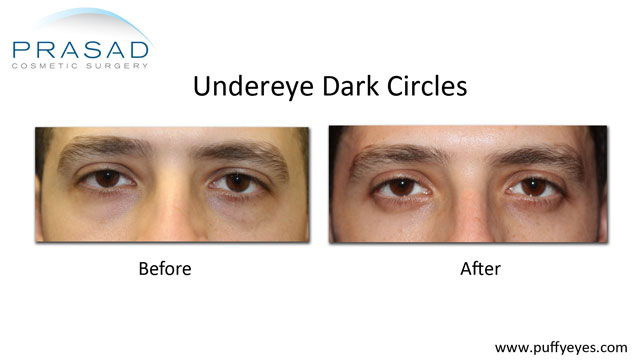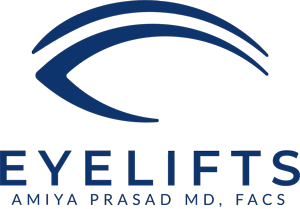Non-Surgical Treatment for Dark Circles
Summary
Dark circles under the eyes can be caused by genetics, thinning skin, blood vessel visibility, or lifestyle factors. Non-surgical treatments like PRP (platelet-rich plasma), dermal fillers, laser, and medical-grade skincare can significantly reduce dark circles appearance. The best treatment depends on your unique anatomy and the cause of your dark circles. A consultation with an expert can help tailor the right treatment plan.
FAQ
What is the best treatment for dark circles?
The best treatment depends on the underlying cause and individual anatomy. Synergistic approaches, such as combining PRP with fillers or lasers, are often recommended for optimal results. Consulting an oculofacial plastic surgeon like Dr. Amiya Prasad ensures a tailored plan that addresses contributing factors like genetics, aging, or lifestyle.
How effective is PRP treatment for dark circles?
Platelet-Rich Plasma (PRP) therapy utilizes your body's own growth factors to rejuvenate the under-eye area, improving skin texture and reducing pigmentation.
What Causes Dark Circles Under Eyes?
- Genetics/Ethnic Background
One of the top causes for dark circles is genetics. People of color, such as those of African descent, Asian, Indian and Middle Eastern backgrounds, can suffer from severe dark circles under the eyes due to pigmentation problems caused by the excess melanin they have in their skin. Some people may also have what is called genetic hyperpigmentation, wherein only certain areas of a person’s body may be darker than the rest.
- Aging
As we age, our skin, especially the thin skin surrounding our eyes, loses collagen and becomes even more thin and translucent. When this happens, the dark veins underneath the skin become more visible and thus contributes to the appearance of dark circles under the eyes. Hollow areas under the eyes also often create shadows, which can make the eyes look tired.
- Sun Exposure
Prolonged exposure to the sun may aggravate hyperpigmentation because it triggers the production of melanin in the body, making dark circles more obvious.
- Allergies
Dark circles can be caused by a multitude of allergies to food, cosmetics, allergens found at home or at the workplace and even hay fever; therefore the problem is often called “allergic shiners”. These allergies can cause inflammation in the tissues around the eyes, which enlarges the tiny blood vessels under the skin, causing the dark color to become more obvious.
Nasal congestion can also cause dark circles because it dilates and darkens the veins that go from your eyes to your nose. Excessive rubbing or scratching of the skin around the eyes can also cause capillaries to break and lead to discoloration as well.
- Diet/Lifestyle Choices
People are often unaware that dark circles are also caused by many lifestyle choices that they make. Habits such as not including a sufficient amount of vitamins and nutrients into their diet, not getting enough exercise, and not getting the appropriate amount of sleep every night contributes to tired-looking dark circles.
Smoking dilates blood vessels, making them appear more swollen, and restricts oxygen flow to the skin, making blood vessels appear darker thus making dark circles more visible.
In terms of our diet, eating too much salty food causes the body to retain water, which in turn causes the veins under our skin to take on a bluer tinge. Having too much caffeine, alcohol or sugar can both dehydrate the body and skin, and can also lead to puffiness in the skin around the eyes, which in turn emphasizes the presence of dark circles.
Non-Surgical Treatment for Dark Circles
1. Moisturization and Hydration
First and foremost, it must be said that eyelid surgery cannot correct or remove dark circles, as this concerns the pigmentation of the skin itself. You may opt to use eye creams to improve the state of your dark under eye circles, however keep in mind that most of these products are just tinted moisturizers. They can improve the quality of skin, but the pigmentation of skin is an entirely different story.
Since dark circles are caused by unavoidable factors such as genetics or the bluish tinge of the blood vessels that can be seen through the thin skin around the eyes, eye creams can only do so much. Laser treatments may work for people with lighter skin; however, this method is known to only worsen the situation for darker-skinned people.
When it comes to dark circles, Dr. Prasad stresses that proper hydration and moisturizing of skin is still an important step. Many forget that, unlike the skin on the rest of our bodies, the skin around the eyes is actually extremely thin (only 0.5mm thick), and therefore requires that moisture even more.
This is especially true for women who constantly wear makeup and subject their skin to harsh astringents and makeup removers every day. In order to address this, Dr. Prasad developed Eye Rescue, a product from his own medical skin care line, which is a combination of a moisturizer and some active ingredients that is specifically designed for the skin around the eyes.
2. Platelet-Rich Plasma (PRP) for Dark Circles
Another approach that can be taken to address dark circles is by means of platelet-rich plasma (PRP). Platelet-rich plasma is derived from the patient’s own blood and contains several growth and regenerative factors. Being that it is taken from the patient, there is a very low risk that allergies or complications will occur.
PRP works by improving collagen production and blood supply in areas where it is lacking—which is ideal for those suffering from genetic dark circles. As skin quality improves with PRP treatment, the thin eyelid skin becomes healthier and thicker. It can also help those who have damaged and dry skin due to lifestyle-related activities that require them to be under the sun a lot.
Hereditary Eye Bags and Dark Circles Treatment
3. Fillers and Platelet-Rich Plasma Combination for Hollow Eyes and Dark Circles
The combination of a hyaluronic acid filler like Restylane and platelet-rich plasma (PRP) is a synergistic approach that improves the efficacy of both materials. The hyaluronic acid filler adds volume to the hollow area beneath the skin, while PRP increases skin thickness.
With PRP’s overall improvement on skin quality, the under eye skin adds a healthy lustre and glow. PRP also adds volumetric improvement. Interestingly, when PRP and hyaluronic acid are combined, the longevity of both materials become longer.

Hyaluronic acid filler used for volume to fill deep tear troughs, with platelet-rich plasma (PRP) used to improve skin quality, texture, color, and thickness.
4. Platelet-Rich Plasma (PRP) and Fractional CO2 Laser Combination for Dark Circles and Wrinkles
Having thin eyelid skin become progressively thinner due to diminishing skin quality can result in wrinkles. Dr. Prasad uses a skin quality improvement combination of platelet-rich plasma (PRP) with fractional CO2 laser. Fractional CO2 laser can improve collagen production and remodeling by stimulating the skin with a limited amount of heat.
Applying too much heat, or applying heat too often with the fractional CO2 laser can diminish skin thickness and quality, so it is important that your doctor understands the safe limits of thermal devices. Platelet-rich plasma’s wound healing factors increases blood supply and spurs collagen rebuilding in the lower eyelid area, making the skin thicker.

Dark circles under the eyes accompanied with wrinkles need a combination treatment of PRP with fractional CO2 laser to resurface the skin and increase collagen production to improve skin quality and reduce pigmentation and wrinkles.
Laser Treatment for Dark Circles
Blepharoplasty and Platelet-Rich Plasma (PRP) Combination for Dark Circles and Bags Under Eye
Dark circles do often accompany puffy under eye bags. While significant puffy eye bags can only be removed surgically with a lower eyelid blepharoplasty, the dark circles are not treated by the surgery.
Platelet-rich plasma (PRP) is often used in conjunction with a lower blepharoplasty to improve the darkness and adjacent hollowing under the eyes, while further quickening the healing of lower eyelid surgery, and improving the quality and thickness of under eye skin.

Eye bags are surgically removed, while dark circles are treated non-surgically with platelet-rich plasma (PRP)
Non-surgical Treatment for Dark Circles in Manhattan, NYC and Long Island, New York
Dr. Amiya Prasad, an oculofacial plastic surgeon with over 25 years of experience in both non-surgical and surgical eye solutions, stresses the importance of choosing a surgeon specializing in these procedures. The area around the eyes is complex and delicate, requiring a deep understanding.
While some treatments may seem simple, they require specialized skill. Many individuals choose Dr. Prasad for their non-surgical dark circle treatments.
For more details about our services and facilities, explore our website or contact us. We are happy to answer any questions you might have.
Before deciding, consider a personal consultation with Dr. Amiya Prasad, a New York eyelid surgery specialist and oculoplastic surgeon. This consultation will help determine the most suitable procedure for your specific needs. Fill up the contact form below or call any of our offices at (212) 265-8877 for Manhattan, New York City or (516) 742-4636 Garden City, Long Island, New York.
Post Reviewed by: Dr. Amiya Prasad
